The series and parallel connection of lithium batteries is a key technology to increase voltage and capacity, but it also contains safety risks. This article will analyze in detail the principles, methods and precautions of series and parallel connection of lithium batteries to help you avoid potential risks and build a battery system correctly. Whether you are a DIY enthusiast or a professional technician, this practical guide will provide you with comprehensive and reliable operation methods.
Last updated: May 2025 | Estimated reading time: 12 minutes

This article will answer your questions:
- The basic principles and differences of lithium battery series and parallel connection
- How to properly connect 12V lithium batteries and multiple battery packs
- Common safety hazards and preventive measures in series-parallel systems
- Matching and connection issues of battery packs of different specifications
- Lithium battery capacity calculation and practical application skills
Table of Contents
ToggleWhat is lithium battery series
Lithium battery series connection is to connect multiple batteries end to end, with the positive electrode connected to the negative electrode of the next battery, which can increase the total voltage without changing the capacity. For example, 4 pieces of 3.7V lithium batteries connected in series can get an output voltage of 14.8V, but the capacity remains unchanged. Series connection is the most common method to make the battery pack reach the required operating voltage.
Series connection is the best choice when you need more voltage rather than more capacity. For example, battery packs for drones or power tools are often connected in series to provide enough voltage to drive the motor. In a series system, the current passes through all the cells, so all the cells must have the same or very similar capacity and internal resistance.
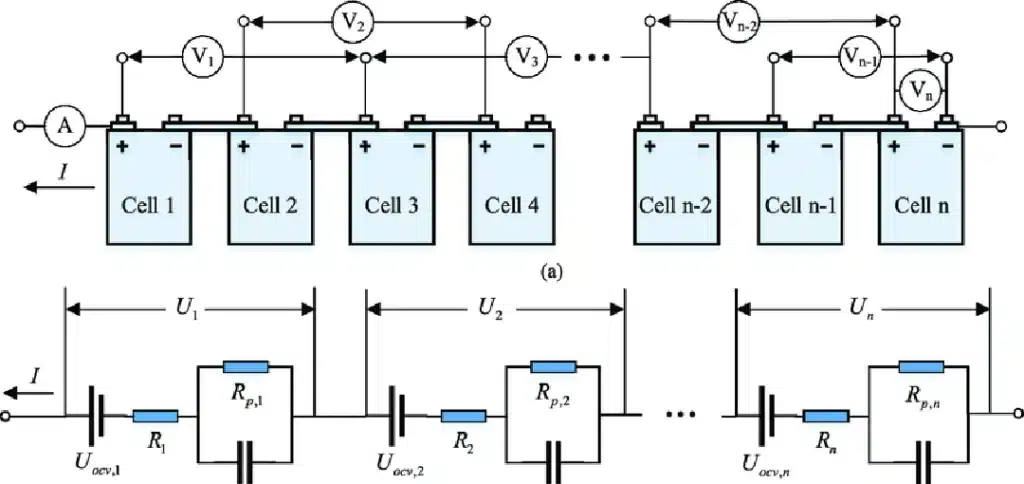
The correct way to connect 4 lithium batteries in series
To properly connect a 4-cell lithium battery system, follow these steps:
- Ensure battery parameters match: All batteries should be of the same model and batch, and the voltage and capacity should be as consistent as possible.
- Prepare appropriate connection materials: Use high-quality copper busbars or wires to ensure sufficient conductivity.
- Correct connection sequence: The positive terminal of the first battery is connected to the negative terminal of the second battery, and so on.
- Check total voltage: For 4 3.7V batteries, the final voltage should be about 14.8V.
- Install appropriate protection board: Choose a BMS protection system that can withstand the total voltage.
| Number of Cells in Series | Nominal Voltage (per cell) | Final Total Voltage | Application Scenarios |
|---|---|---|---|
| 3 | 3.7V | 11.1V | Portable Devices, LED Light Strips |
| 4 | 3.7V | 14.8V | Laptops, Small Drones |
| 7 | 3.7V | 25.9V | Power Tools, Small Electric Vehicles |
| 13 | 3.7V | 48.1V | Electric Bicycles, Home Energy Storage Systems |
Common problems and solutions when connecting in series:
- Voltage imbalance: Use a balancing charger or a BMS system with balancing function.
- The protection board has insufficient voltage resistance: Select a protection board that can withstand at least 1.5 times the total voltage.
- Poor contact at connection points: Use high-quality connectors and ensure that the contact surfaces are clean and free of oxidation.
- Heat dissipation problem: Keep appropriate distance between batteries and add heat dissipation design.
An electronics enthusiast used four 18650 lithium batteries in series to power a small robot, but ignored the difference in internal resistance between the batteries, which caused one battery to over-discharge and eventually damage the battery. After using a balancing function BMS, the same battery system worked stably for more than 300 cycles.
To learn more about issues related to charging lithium ion batteries in series, please refer to our best practices for charging lithium ion batteries in series.
What is lithium battery parallel
Lithium battery parallel connection is to connect the positive poles of multiple batteries together, and the negative poles together, so that the total capacity can be increased while keeping the voltage unchanged. For example, after two 3.7V/2000mAh batteries are connected in parallel, the voltage is still 3.7V, but the capacity is increased to 4000mAh. Parallel connection is an effective way to increase battery life.
Parallel systems are suitable for applications that require long-term power supply but low voltage requirements, such as portable power or backup power systems. Parallel connections are more tolerant than series connections, but attention must still be paid to the matching of battery parameters, especially internal resistance and voltage.
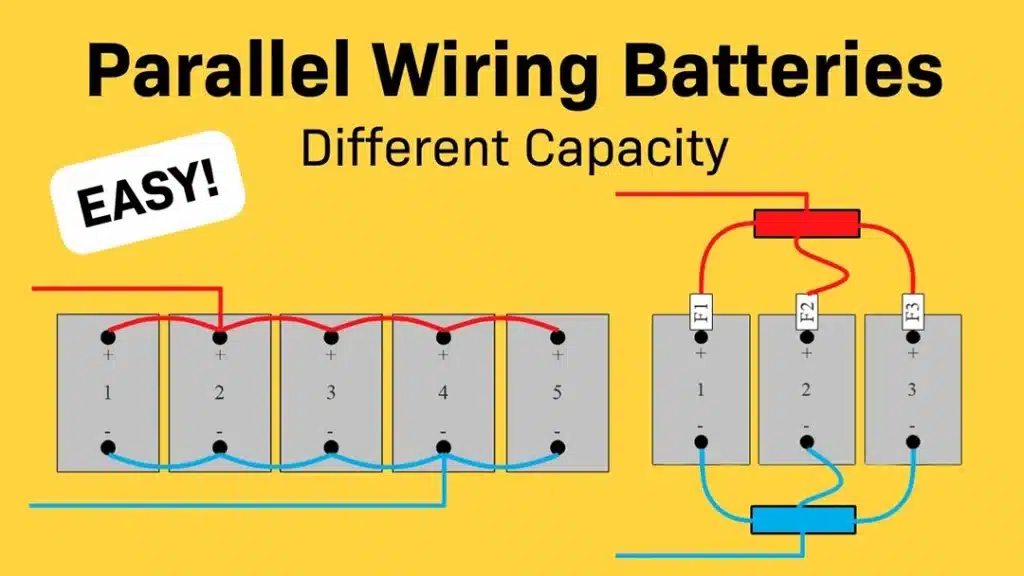
Safety considerations for parallel lithium batteries
Although connecting batteries in parallel may seem simple, there are potential risks:
- Voltage differences lead to mutual charging: higher voltage batteries will charge lower voltage batteries with high current, which may cause overheating.
- Different internal resistances of batteries exacerbate imbalance: Batteries with lower internal resistance will bear more discharge current, resulting in uneven attenuation.
- Risk of fault propagation: A problem with one battery may affect the entire system.
- Heat dissipation problem at the connection point: The resistance and heat dissipation of the parallel connection point must be properly handled.
To ensure safety, parallel systems must:
- Use batteries with consistent parameters: same model, same batch, and same capacity.
- Add parallel protection device: Control the mutual charging current between batteries.
- Make sure to connect batteries in parallel in a fully charged state: fully charge each battery individually before initial connection.
- Use thick, high-quality wire: Reduces impedance at the connection point.
- Monitor Temperature: Install temperature sensors to monitor hot spots.
How to safely charge batteries in parallel?
Specific principles must be followed when charging parallel lithium battery packs:
- Use a matching charger: The voltage must be suitable for the nominal voltage of the individual batteries.
- The current setting is reasonable: usually 0.2-0.5C of the total capacity after parallel connection.
- Monitor temperature: The charging process should not cause any battery to overheat.
- Adding balancing capabilities: Even in a parallel system, differences can still occur between cells.
| Charging Method | Advantages | Disadvantages | Suitable Situations |
|---|---|---|---|
| Individual Cell Charging | Safest, prevents cross-charging | Time-consuming, requires disassembly | Situations requiring high safety |
| Charger with Balancing Function | Maintains cell balance | Higher cost | Professional applications |
| Standard Charger (Direct Charging) | Simple and convenient | Potential for imbalance | Batteries with highly consistent parameters |
A home energy storage system uses 12 parallel lithium iron phosphate batteries. No balancing measures were taken at the beginning, and the capacity difference reached 15% after 6 months. After installing the parallel balancing module, the imbalance was reduced to less than 3%, and the system life was greatly extended.
Detailed explanation of lithium battery parallel connection
The most common danger in parallel systems comes from the “cross-charge current” between batteries. When batteries with different voltages are connected in parallel, the high-voltage battery will discharge to the low-voltage battery, and the current depends on the voltage difference and internal resistance. If the voltage difference between the two batteries is 2V and the internal resistance is only 2mΩ, the cross-charge current can theoretically reach 1000A, which is enough to cause serious safety accidents.
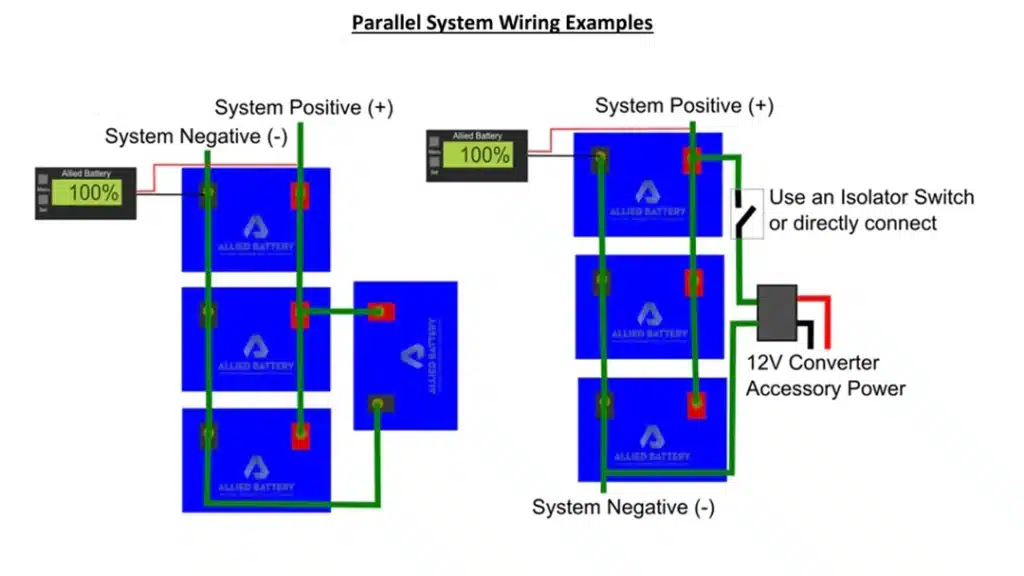
Key elements for safe parallel connections:
Parameter matching: All batteries connected in parallel should have the same:
- Chemical composition (e.g. all NMC or all LFP)
- Nominal voltage
- Capacity (deviation should be less than 5%)
- Internal resistance (deviation should be less than 10%)
- Production batch (preferably the same batch)
Parallel protection device: Install a dedicated parallel protection module to effectively control the mutual charging current within a safe range.
Connection materials and methods:
- Use copper busbars instead of thin wires
- Use star topology instead of chain connection
- Make sure all connection points are in good contact and not loose.
Monitoring system:
- Temperature sensors monitor hot spots
- Current distribution monitoring to detect imbalance in time
Incorrect examples and correct methods of parallel connection:
| Incorrect Practice | Potential Danger | Correct Practice |
|---|---|---|
| Directly Paralleling Different Battery Models | Internal resistance differences lead to uneven current distribution | Only parallel the same battery model |
| Mixing New and Old Batteries | Capacity differences lead to over-discharge | Only parallel batteries used at the same time |
| Directly Paralleling Without Protection | Excessive cross-charging current leads to overheating | Add parallel protection module |
| Chain-Connecting Multiple Batteries | Uneven current distribution | Use a star topology connection |
How to make a safe high capacity parallel battery pack
If you plan to make your own high-capacity battery pack, please follow these steps:
- Choose the right battery: Buy batteries from the same batch and model.
- Measure the open circuit voltage of each battery, measure the internal resistance, and fully charge and discharge it 2-3 times to confirm the performance.
- Group matching: group by similarity of parameters.
- Use a copper busbar that is thick enough (calculate the maximum current), the length of all connection paths should be as equal as possible, and use a star topology connection.
- Protection system installation: Add dedicated parallel protection devices, install temperature sensors, and consider current shunt monitoring.
A DIY enthusiast built a 48V/100Ah energy storage system using 16 parallel lithium iron phosphate battery packs. He used copper bars to form a star topology and installed four parallel balancing modules. The system has been running for three years without any obvious imbalance, and the temperature difference of all batteries is controlled within 3°C.
Detailed explanation of lithium battery series connection
The 12V lithium battery series system requires stricter parameter matching and a higher specification protection system. When multiple 12V lithium batteries are connected in series, the total voltage increases rapidly, and the voltage resistance requirements for the protection board increase exponentially. The voltage resistance value of the standard 12V lithium battery protection board on the market is usually only about 35V, which is completely insufficient to meet the requirements of the 48V series system.
When multiple 12V batteries with protection boards are connected in series, if the protection function of a battery pack is triggered to disconnect, the B- and P- terminals on its protection board must withstand the total voltage of all other battery packs. Taking four groups of 12V batteries as an example, when one group is disconnected, its protection board needs to withstand a voltage of 36V, which exceeds the standard protection board’s 35V withstand voltage value, which can easily cause the protection board to break down.
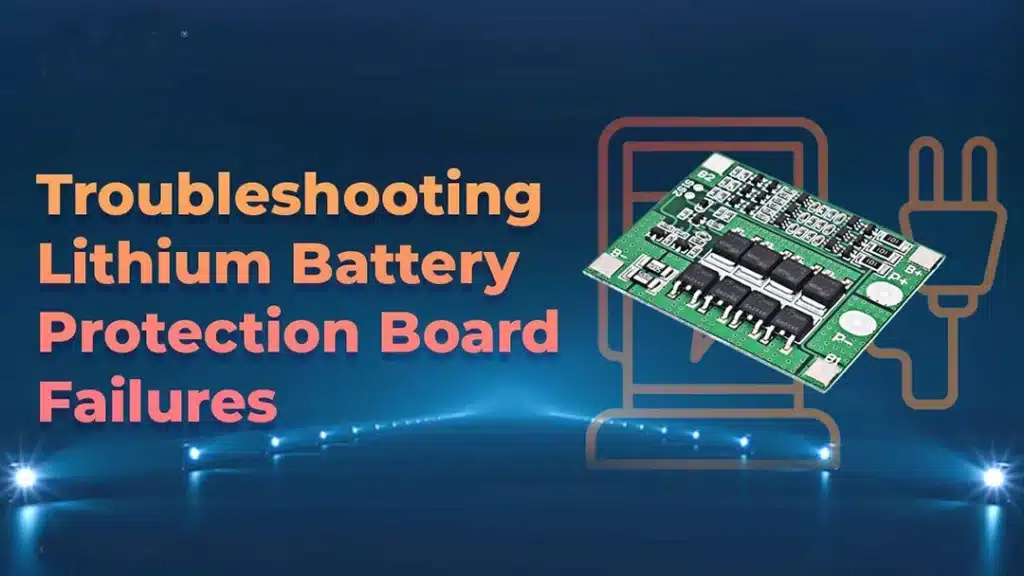
A solution for safely connecting 12V lithium batteries in series
To safely connect 12V lithium batteries in series, the following options should be considered:
- Customized high voltage protection board: 48V system requires a protection board with a voltage of at least 80V, and the MOSFET selection must match the total voltage.
- System-level protection design: Use a centralized BMS to manage multiple battery groups, avoiding the use of multiple independent protection boards.
- Battery pack consistency control: Strictly screen battery packs with consistent parameters and implement regular balancing measures.
- Alternative solution: Consider directly using single cells in series to achieve the required voltage and using a professionally designed overall battery pack.
Comparison of safety solutions for different series connection systems:
| Series Configuration | Safety Risk | Recommended Protection Scheme | Application Scenarios |
|---|---|---|---|
| 3-4 Single Cell Batteries in Series | Low | Standard BMS | Portable Electronic Devices |
| 2 Sets of 12V Lithium Batteries in Series | Medium | Custom 60V Voltage-Resistant BMS | 24V System Equipment |
| 4 Sets of 12V Lithium Batteries in Series | High | Custom 100V Voltage-Resistant BMS | 48V System Equipment |
| 8 Sets of 12V Lithium Batteries in Series | Very High | Professionally Designed Segmented Protection | Industrial-Grade Energy Storage Systems |
Common misunderstandings about 12V lithium battery series connection:
- Myth 1: It is believed that 12V lithium batteries can be directly connected in series like lead-acid batteries.
- Myth 2: Thinking that ordinary protection boards are sufficient to handle high-voltage systems.
- Myth 3: Ignoring the parameter matching requirements between battery packs.
- Myth 4: Failing to consider performance differences after long-term use.
A customer connected four 12V lithium iron phosphate batteries in series for a motorhome, using a standard protection board. Three months later, during a discharge process, one protection board was short-circuited, causing the battery pack to be severely damaged by over-discharge. After replacing it with a customized 80V withstand voltage protection board, the system ran stably. Click to learn more about our 12V LFP battery products.
Battery pack capacity and power calculation
The formula for calculating the power of a lithium battery is: Power (Wh) = Voltage (V) × Capacity (Ah). For example, a 3.7V/2000mAh battery has a power of 3.7V × 2Ah = 7.4Wh. Understanding this basic calculation formula will help you understand the power change rules of series-parallel systems.

Series system power calculation:
- Voltage = single cell voltage × number of series connections
- Capacity = Single cell capacity (in Ah)
- Total power (Wh) = total voltage × single cell capacity
Parallel system power calculation:
- Voltage = cell voltage
- Capacity = single cell capacity × parallel quantity
- Total power (Wh) = cell voltage × total capacity
Calculation of power for series-parallel combination:
- Total voltage = single cell voltage × number of series connections
- Total capacity = single cell capacity × number of parallel connections
- Total power (Wh) = total voltage × total capacity
Take a 4S3P 18650 battery pack as an example:
- Cell voltage: 3.7V, Cell capacity: 3000mAh
- Total voltage: 3.7V × 4 = 14.8V
- Total capacity: 3Ah × 3 = 9Ah
- Total power: 14.8V × 9Ah = 133.2Wh
| Connection Method | Voltage Change | Capacity Change | Energy Change | Best Application Scenario |
|---|---|---|---|---|
| Series (nS) | n-fold Increase | No Change | n-fold Increase | High Voltage Applications |
| Parallel (nP) | No Change | n-fold Increase | n-fold Increase | Long Runtime Applications |
| Hybrid (nSmP) | n-fold Increase | m-fold Increase | n x m-fold Increase | High Power Applications |
There is a difference between the theoretically calculated battery capacity and the actual available capacity, which is mainly affected by the following factors:
- Conversion efficiency loss: DC-DC conversion: about 5-10% loss, DC-AC inverter: about 10-20% loss.
- Temperature effect: Low temperature (0°C): capacity decreases by about 20-30%, high temperature (45°C): performance decreases and aging is accelerated.
- Discharge depth limit: To extend the life, the discharge depth is usually limited to 80%. Actual available capacity ≈ theoretical capacity × 80%.
- Connection point loss: The series connection point resistance causes about 2-5% loss, and the loss is more obvious in high current systems.
A 48V/20Ah lithium battery pack (theoretical capacity 960Wh) is converted to 220V AC by a DC-AC inverter and works in a low temperature environment of 0°C. The actual available power is about 960Wh × 80% × 70% × 85% ≈ 457Wh, which is less than half of the theoretical value.
Lithium battery assembly practical guide
Preparation before assembly is essential, including the proper working environment, safety equipment, and necessary tools. Battery welding and connection is a technical job that requires certain skills and experience. Beginners should start with simple projects and gradually improve their skills.
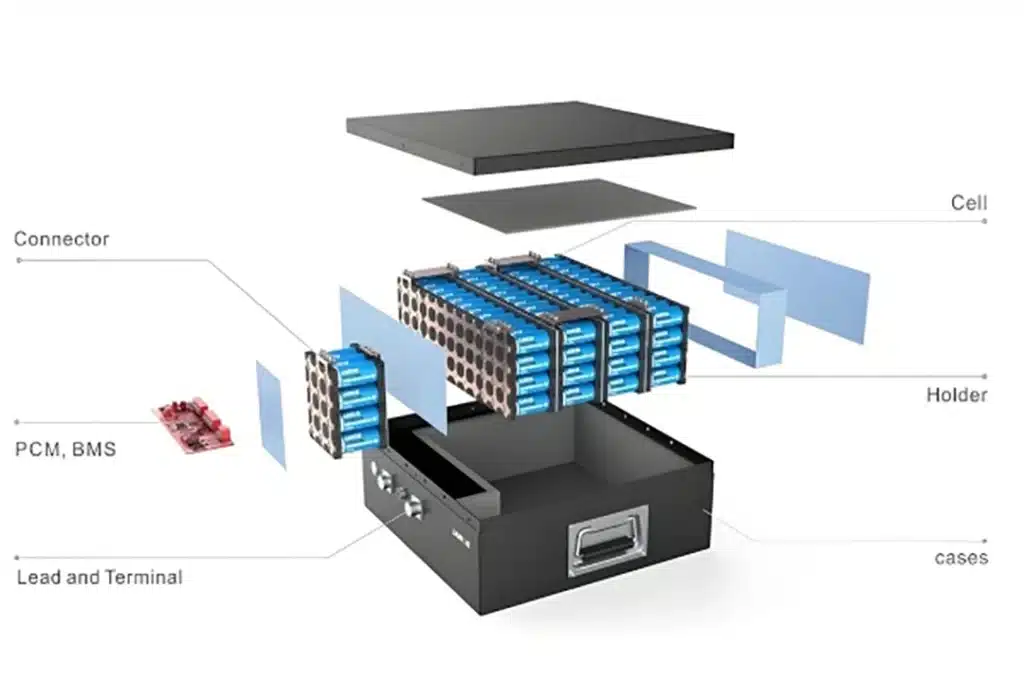
- High-quality lithium batteries (same model, same batch)
- Nickel sheet or copper busbar (0.1-0.2mm thick)
- Appropriate BMS protection board
- Battery connecting wire (silicone wire of appropriate specifications)
- Insulating material (fish paper, FR4 board, etc.)
- Insulated gloves and goggles
- Precision multimeter (to measure voltage and internal resistance)
- Soldering equipment suitable for the battery (spot welder is better than soldering iron)
- Insulating tape (polyimide/Kapton tape)
- Heat shrink tubing (various sizes)
- Battery holder or mounting structure
| Assembly Step | Common Mistake | Correct Practice | Why It’s Important |
|---|---|---|---|
| Welding Connection | Prolonged Heating of Battery | Rapid Spot Welding, <2 Seconds | Avoid Internal Heat Damage to Battery |
| BMS Connection | Confusing B- and P- Wires | Connect B- Wires First, then P- Wires | Prevent BMS Protection Function Failure |
| Insulation | Neglecting Adjacent Connection Points | Completely Insulate All Conductors | Prevent Short Circuit Risk |
| Battery Fixation | Overly Tight Fixation | Allow Slight Expansion Space | Allow Normal Operational Expansion |
After assembly is complete, a comprehensive test must be performed:
- Measure the total voltage to see if it meets expectations
- Measure the insulation between the terminal and the housing
- Overcharge protection test
- Over-discharge protection test
- Short-circuit protection test
- Test the discharge curve using an appropriate load
- Monitor temperature changes
- Confirm that the capacity meets the design
- Complete 3-5 full charge and discharge cycles
- Confirm that there is no abnormal temperature rise
- Verify capacity stability
Detailed explanation of lithium battery protection board
The lithium battery protection board (BMS) is a key component for the safe operation of lithium battery packs. Choosing a suitable protection board can not only prevent battery overcharge, over discharge, short circuit and other problems, but also extend the battery life and ensure the reliability of the entire system. Understanding the working principle and selection criteria of BMS is crucial to building a safe battery system.
The main functions of the BMS system include battery protection, battery balancing, status monitoring, and interface communication. Battery systems for different purposes have different requirements for BMS, ranging from simple protection functions to complex intelligent management systems. It is necessary to select a suitable BMS according to the actual application scenario.
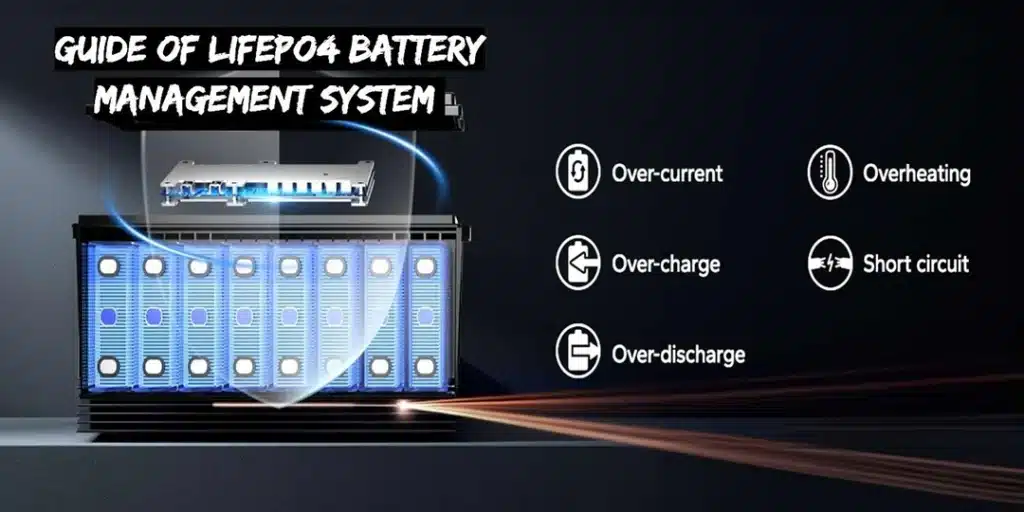
BMS core protection functions:
- Overcharge protection: prevents the voltage of a single cell from exceeding the upper safety limit
- Overdischarge protection: prevents damage caused by deep discharge of the battery
- Overcurrent protection: limits the charge and discharge current to a safe range
- Short circuit protection: detects and disconnects short circuit current
- Temperature protection: monitors temperature and cuts off the circuit in case of abnormality
- Balance function: balances the voltage difference of each single cell
| Parameter | Description | How to Choose | Impact on System |
|---|---|---|---|
| Series Cell Count | Max Series Battery Count Supported by BMS | Must Match Battery Pack Series Count | Determines System Voltage |
| Max Working Current | Continuous Working Current Capability | Should be 1.5x Greater than System Max Load Current | Affects System Power |
| Balancing Current | Ability to Balance Individual Cells | Choose Based on Battery Capacity (Typically 50-300mA) | Affects Long-Term Consistency |
| Voltage Endurance | Max Voltage Tolerance of BMS Components | Should be 1.5x Greater than System Max Possible Voltage | Impacts System Safety |
| Communication Function | Data Transmission and Monitoring Capability | Decide Based on Need for Remote Monitoring | Affects System Intelligence |
A solar system integrator selected a 16-series 50A smart BMS with balancing function for a 48V home energy storage system, which supports Bluetooth monitoring. A comprehensive test was conducted before use, and it was found that the actual overcurrent protection point was 58A, slightly higher than the nominal value. After adjusting the system design to adapt to this parameter, the energy storage system has been running stably for more than 2 years, and the battery pack capacity decay is uniform and within the expected range.
The latest development and trend of lithium battery series and parallel technology in 2025
Lithium battery series-parallel technology will see a number of innovative breakthroughs in 2025, improving system safety and service life. The latest intelligent BMS system, modular design and new connection methods are changing the integration of traditional lithium battery packs. These technological advances make lithium battery systems safer and more reliable while reducing manufacturing and maintenance costs.
- Adaptive BMS technology: It can automatically adjust protection parameters according to battery status and usage environment, improve system safety and battery utilization, and extend battery life by more than 20%.
- Cell-level balancing technology: From traditional passive balancing to active balancing, the balancing current is increased to 1-2A, which greatly reduces the imbalance problem of battery packs and improves capacity utilization by about 15%.
- Wireless BMS connection: Reduces the number of physical connection cables in traditional BMS systems, reduces failure points, improves system reliability by about 30%, and simplifies manufacturing and maintenance processes.
- Modular battery design: Standardized battery modules support hot swapping, which facilitates system expansion and maintenance, shortens system integration time by 60% and reduces maintenance costs by about 25%.
- Carbon nanotube conductive material: A new type of connection material that replaces traditional copper busbars, reducing weight by 80%, improving conductivity by 30%, and having better corrosion resistance and flexibility.
Conclusion
The series and parallel connection of lithium batteries is an effective way to increase the system voltage and capacity, but strict safety guidelines must be followed. Series connection increases voltage without changing capacity, while parallel connection increases capacity without changing voltage. Regardless of the method used, battery parameter matching and appropriate protection systems are key factors to ensure safe operation.
The safety of the battery system is not only related to the performance of the equipment, but also directly affects the safety of the user. Especially for the 12V lithium battery series system, the problem of insufficient voltage resistance of the protection board must be considered, and a customized high-voltage protection board or a centralized BMS system must be selected. Correctly calculating the battery capacity and selecting the appropriate BMS system are equally important, which directly affects the practicality and life of the system.
Need professional lithium battery solutions or technical consultation? Please contact us for free technical support and samples.
FAQs
It is not recommended to directly connect 12V lithium batteries with protection boards in series. The voltage resistance of ordinary 12V lithium battery protection boards is usually only about 35V, which may cause the protection board to break down after series connection. If series connection is necessary, a specially customized high-voltage protection board (at least 80V voltage resistance) should be used, or a centralized BMS system should be used to manage all batteries.
Although it is technically feasible, it is not recommended to use lithium batteries of different capacities in parallel. The capacity difference will lead to uneven discharge, and the smaller capacity battery may reach the cut-off voltage too early. If mixed use is necessary, the capacity difference should be controlled within 10%, and a parallel protection device should be added to control the mutual charging current.
The key to extending the life of a series lithium battery pack is to maintain the voltage balance of each battery cell. Using a BMS system with a balancing function, controlling the depth of charge and discharge between 20-80%, avoiding extreme temperature environments, and regularly performing complete charge and discharge cycles to calibrate the BMS system can effectively extend the battery life.
